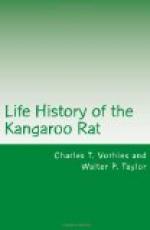ECONOMIC CONSIDERATIONS.
In May, 1894, Fisher found a ranchman at Willcox, Ariz., who complained more bitterly of the depredations of spectabilis than of those of any other mammal.
On the United States Range Reserve the food material appropriated by the kangaroo rat during good years is inappreciable. There is such an excess of forage grass produced that all the rodents together make very little difference. But with the periodic recurrence of lean years, when drought conditions are such that little or no grass grows, the effects of rodent damage not only become apparent, but may be a critical factor determining whether a given number of domestic animals can be grazed on the area (Pl. VIII, Fig. 2).
With two kangaroo rats to the acre (1,280 per square mile), there would be 64,000 animals on the 50 square miles of the Range Reserve. If each rat stores 4 pounds of grass seeds and crowns and other edible forage during the season (and in severe seasons we find that more crowns are stored than under ordinary conditions), a total of 256,000 pounds, or 128 tons, of edible forage are rendered unavailable to stock. In dry years it is probable that this amount of forage would be of critical importance. Allowing 50 pounds of food a day for each steer, the forage destroyed would be sufficient to provide for the needs of one steer for 5,120 days, or for the needs of 14 steers for one year. On a stock ranch the size of the Range Reserve this might mean the difference between success and failure.
It seems not unlikely, therefore, that during seasons of drought the banner-tailed kangaroo rat, where it is abundant on the grazing ranges of the Southwest, may be a factor of critical importance in relation to forage production and carrying capacity. It must be remembered, moreover, that the stored material consists largely of seeds, so that this loss is of greater importance than would be the case were it ordinary forage. Some of the range grasses of this region found in greatest quantity in the stored material depend in large part, under certain conditions, upon seed reproduction. Rehabilitation of a depleted range after severe drought and consequent close grazing and trampling is retarded by the heavy toll of seed taken by the kangaroo rats.
CONTROL.
Kangaroo rats may be easily eradicated by the use of the poisoned grain used for prairie-dog control by the Biological Survey and the University of Arizona Extension Service. This can be obtained by application to the State representative of the Biological Survey or to the local county agricultural agent, or may be mixed as follows:




